Peperomia Obtusifolia (American Baby Rubber Plant): Care and Growing Guide (Pictures)
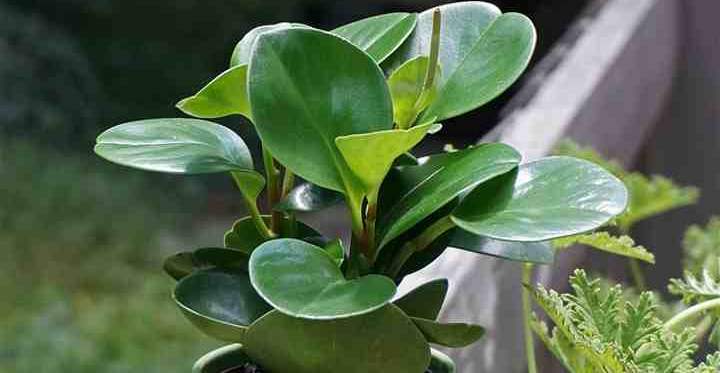
Peperomia obtusifolia (American baby rubber plant) is a compact perennial houseplant with rounded, leathery green leaves. Baby rubber plants are prized for their shiny, bushy foliage that can be dark green, light green, or have variegated succulent-like leaves. Peperomia obtusifolia produces white, non-showy flower spikes in spring.
Although native to tropical countries, baby rubber plants thrive indoors. Thanks to its compact growth, the evergreen bushy peperomia obtusifolia plant only grows to about 10” (25 cm) tall. The lush-foliage and low-maintenance make this peperomia species an ideal potted plant.
This article is a complete guide to growing Peperomia obtusifolia indoors. You’ll find the best care tips to ensure that your baby rubber plant thrives and enhances your interior.
What is American Baby Rubber Plant (Peperomia Obtusifolia)?
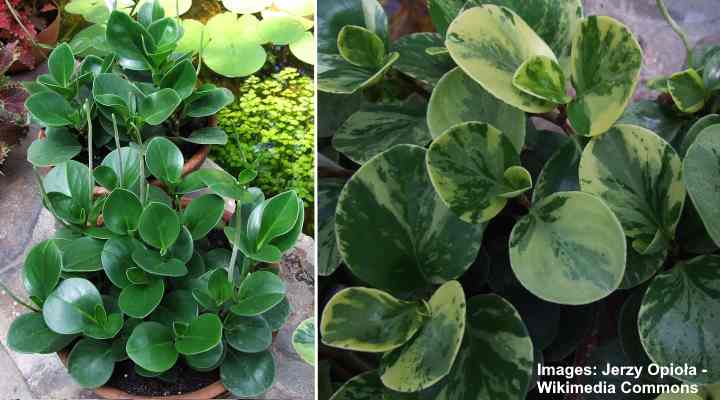
Baby rubber plant (Peperomia obtusifolia) has green foliage with some variegated species
Peperomia obtusifolia is an evergreen perennial in the family Piperaceae. Collectively, plants in the Peperomia genus are called radiator plants. As well as species with dark green leaves, some Peperomia obtusifolia species have foliage with green and yellow or cream variegation. Its distinguishing features are thick upright stems, cupped round leaves, and a compact, bushy appearance.
Also called the baby rubber plant, Peperomia obtusifolia is a flowering plant species native to Central America and Florida.
Peperomia obtusifolia is also called ‘pepper face,’ ‘peperomia frost,’ ‘peperomia green,’ and ‘blunt-leaved peperomia.’ The botanical name of the species obtusifolia literally means “blunt-leaved.” The common name “pepper face peperomia” is from the fact that these plants are related to pepper plants.
Despite being called baby rubber plant, Peperomia obtusifolia is not related to “true” rubber plants (Ficus elastica)—ornamental indoor trees in the genus Ficus.
How to Care for Baby Rubber Plant – Overview
Peperomia obtusifolia thrives in bright indirect light, growing in well-draining soil and high humidity. Water baby rubber plants when the potting mix partially dries. Mist foliage occasionally to increase humidity. Peperomia’s ideal temperature range is 64°F to 75°F (18° – 24°C). You can apply fertilizer once or twice in spring and summer to encourage growth.
Peperomia obtusifolia plants also grow well in the shade or under fluorescent lights. This low light tolerance makes pepper-face peperomia plants ideal for bathrooms, offices, or north-facing rooms.
However, pretty variegated baby peperomia plants need a bit more care. Peperomias with variegation require plenty of bright indirect light and some direct sunlight to keep their leaf patterns vibrant. A variegated Peperomia obtusifolia may lose its variegation if growing in the shade for too long.
Variegated Peperomia Obtusifolia – Variegated Baby Rubber Plants
Some of the most attractive varieties of Peperomia obtusifolia are variegated types. Variegated baby rubber plant cultivars can have green leaves with various yellow, gray, gold, or creamy-white patterns.
Here are some of the most stunning types of variegated Peperomia obtusifolia:
Variegated peperomia obtusifolia—This variegated radiator plant has cream to pale-yellow leaf edges with dark green centers.

Peperomia obtusifolia ‘Variegata’
‘Greengold’ variegated peperomia—The thick glossy leaves of ‘Greengold’ variegated pepper face peperomia have shades of green and yellow variegation.
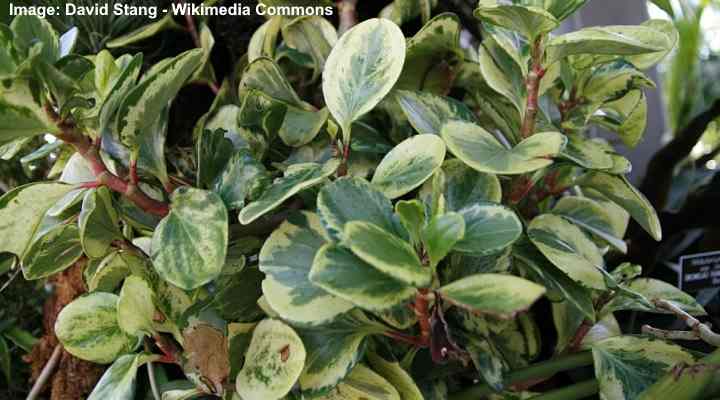
Peperomia obtusifolia ‘Greengold’
‘Golden gate’ peperomia—Large round succulent-like leaves with yellow and green marbling identify this variegated peperomia.
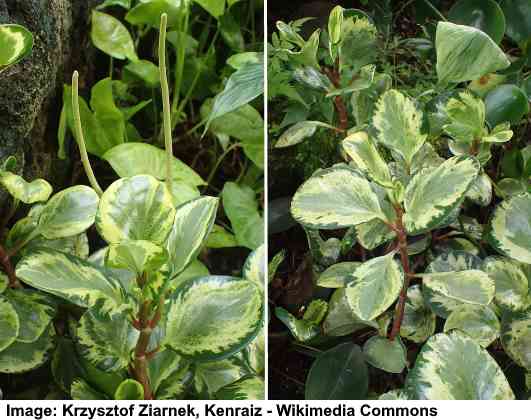
Peperomia obtusifolia ‘Golden Gate’
Peperomia Albo-marginata—The thick waxy leaves have broad ivory to creamy-yellow margins with a dark green center. The shape of the green center often resembles an oak-tree leaf.
Peperomia obtusifolia ‘Alba’—This baby rubber plant cultivar has variegation of lime green and yellow to ivory-colored patches that create stunning houseplant foliage.
Peperomia Obtusifolia Flowers
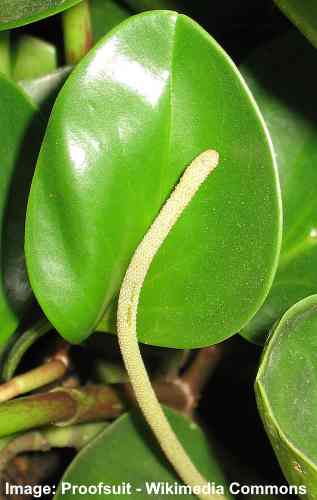
Peperomia obtusifolia flower spike
Peperomia obtusifolia is a species of flowering perennial tropical plant. Like most species of peperomia, the baby rubber plant produces flowering spikes consisting of tiny flowers. The Peperomia obtusifolia has white flowers that grow about 5” (12 cm) long. Peperomias usually flower in spring, if conditions are right.
Growing peperomia obtusifolia plants indoors rarely produces flowers. However, you don’t need to be disappointed. The peperomia flowers are relatively insignificant. Most houseplant owners prize peperomias for their lush foliage and minimal care requirements.
Peperomia Obtusifolia (Baby Rubber Plant) Care Guide
Easy-care baby rubber plants don’t require much maintenance at home. As long as the compact, bushy plant gets medium light, and the soil is never too damp, you should have no problems. In fact, Peperomia obtusifolia often thrives on a little neglect.
Let’s look in more detail at how to care for a potted Peperomia obtusifolia so that it grows for many years in your home.
Peperomia Obtusifolia Light Requirements
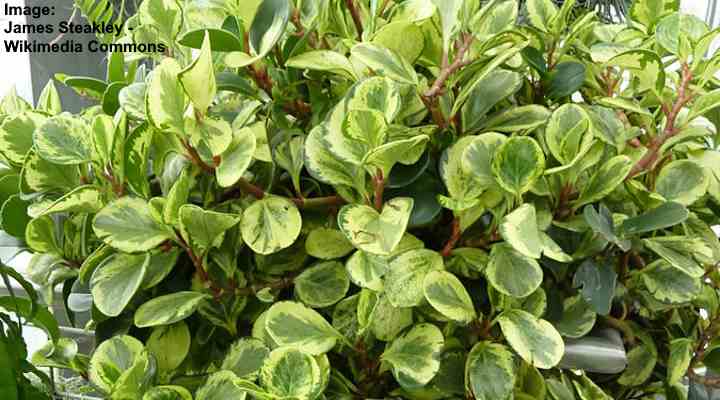
Variegated Peperomia obtusifolia species require plenty of bright indirect light to keep their leaf patterns vibrant
Peperomia obtusifolia plants grow quickly in medium to bright indirect light. Because the sun can scorch the leaves, it’s best to keep the succulent-like foliage out of direct sunlight. Place the peperomia plant pot on a windowsill in an east- or west-facing room. Or, put near a south-facing window behind a sheer curtain for protection.
As an easy-to-care-for houseplant, baby rubber plants grow well in shaded areas. The plant needs some light to grow, and it grows well under artificial or fluorescent lights. Due to its love of humid conditions, you can also keep peperomias in bathrooms.
Here are few care tips for getting light conditions right for your Peperomia obtusifolia:
- Sunlight—Protect the plant from direct sunlight to prevent leaf burn. If you have a variegated variety of pepper face peperomia, remember that the plant benefits from some sunlight so that leaves don’t lose their colors.
- Shade—Peperomia obtusifolia may become leggy growing in full shade. Also, the thick waxy leaves could turn dark green. To prevent leggy growth, ensure your plant gets some light.
Baby Rubber Plant Soil
Grow Peperomia obtusifolia in a potting mix that has excellent drainage. Make a suitable peperomia soil by mixing two parts peat moss with one part perlite. You can also use other potting soil combinations. Still, the most crucial factor for peperomia care is that the soil must drain well.
Using peat moss in a potting mix provides nutrients for healthy plant growth. Peat sphagnum moss also retains some moisture to keep roots hydrated and healthy. Adding soil amendments such as perlite helps increase drainage. But you could also use coarse sand, crushed granite, pumice, or poultry grit to aerate the soil.
Peperomia plants, like types of succulents and cacti, don’t like standing in soggy soil. The shallow root system can quickly start to rot if the soil stays overly damp for too long. Therefore, it’s crucial to allow the soil to dry between waterings.
How to Water Peperomia Obtusifolia
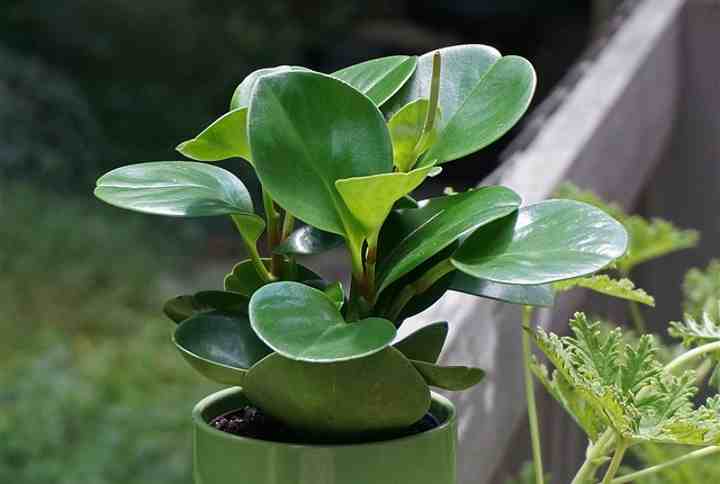
To care properly for your peperomia obtusifolia, wait until the top layer of the soil dries before watering
Water baby rubber plants only when the potting mix partially dries. In warm weather, you may need to water a Peperomia obtusifolia as often as once a week. However, in winter, watering every two or three weeks is usually enough. But the most crucial care factor is that the top layer of soil should be dry before watering.
To water a blunt-leaved peperomia, thoroughly drench the soil. Allow all the excess water to drip out the pot’s drainage holes. Then put the bushy houseplant back in a sunny location. Before watering the plant again, check to see that the top 2” to 3” (5. – 7.5 cm) of soil is dry.
You don’t need to worry about giving the plant soil a good soak, as long as you allow the soil to dry between watering. The “drench and dry” method makes sure that the roots get enough moisture without the soil becoming waterlogged.
One mistake to avoid when watering Peperomia obtusifolia is to water on a set schedule. Various factors can affect how often you should water baby rubber plants.
Here are a few practical tips to water Peperomia obtusifolia plants:
- Water peperomias less often in winter because the plant grows slower, and it absorbs less moisture.
- Peperomia houseplants need watering more often in warm weather because moisture evaporates faster.
- Plastic pots and glazed pots retain moisture more than terracotta pots.
- A rootbound plant will drain slower and require less frequent watering.
Peperomia Obtusifolia Temperature Range
American rubber plants thrive in average room temperatures. However, there should be minimal temperature fluctuation. The ideal temperature range for Peperomia obtusifolia is 64°F to 75°F (18° – 24°C). The absolute minimal temperature for growing peperomias is 50°F (10°C). It’s vital to keep peperomia houseplants out of cold drafts.
Baby rubber plants grow faster in warm temperatures, like their natural habitat. Getting the right temperature is rarely an issue for peperomia houseplants. But there are a few care essentials to remember for these tropical plants. These are:
- Although called radiator plants, Peperomia obtusifolia doesn’t grow well if placed next to a hot radiator.
- In summer, keep the houseplants away from cold air, such as air-conditioning airflow or drafty windows.
Peperomia obtusifolia pepper plants grow outdoors in USDA zones 10 and 11. So, you can take the potted plants outside in the summer and place them in dappled sunlight.
Peperomia Obtusifolia Humidity Requirements
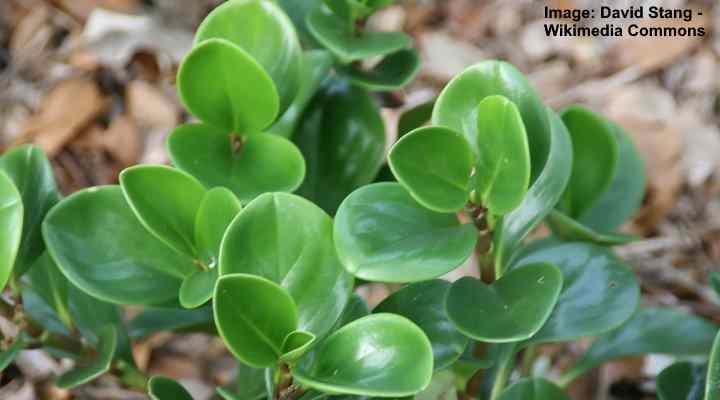
Being a tropical plant, the American baby rubber plant needs high humidity to thrive
Baby rubber plants grow best in high humidity, just like their natural tropical habitat. Mist the plant’s leaves every other day with filtered water to keep humidity levels high. However, as long as your household air isn’t too dry, you may not have to mist the plant at all.
Peperomia obtusifolia is a type of epiphyte plant—meaning it draws moisture and nutrients from its surroundings. So, when growing indoors, some extra humidity will encourage faster, healthy growth.
Here are some care tips on humidifying baby rubber plants:
- Place the peperomia houseplant on a pebble tray with water so evaporation can humidify foliage.
- Grow peperomias together with other indoor plants to create a humid growing environment.
- Use a room humidifier if you have exceptionally dry air or care for many tropical houseplants.
How to Fertilize Baby Rubber Plants (Peperomia Obtusifolia)
Extra feeding can boost Peperomia obtusifolia plant growth. Apply a diluted houseplant fertilizer once in spring and once in summer to encourage faster growth. However, as a slow-growing epiphyte, you might never have to apply fertilizer. If you care for a baby rubber plant well, the plant will grow well without supplemental feeding.
In most cases, if you notice any growth issues—drooping or yellowing leaves—it’s a light or moisture issue, not nutrition. In fact, over-fertilizing a peperomia can cause similar problems as too much water or direct sunlight.
Repotting Peperomia Obtusifolia Plants
Baby rubber plants rarely require repotting for two reasons—they enjoy being rootbound, and they are slow-growers. However, repotting every two or three years is good for healthy growth. Repotting peperomias give you a chance to refresh the potting mix. Also, when replacing the soil, you can check for signs of root rot.
You know it’s time to repot a Peperomia obtusifolia if you see roots poking out the bottom. Choose a pot that is one size larger than its current one. Then transfer the pepper face peperomia to the new pot and plant with fresh potting soil.
If you decide to divide the peperomia for propagation, you could use the existing pot. Just remember to discard old potting soil, sterilize the container, and use fresh soil to replant your leafy, green plant.
How to Propagate Peperomia Obtusifolia
It’s easy to propagate baby rubber plants by leaf cuttings. All you need to do is cut off a healthy leaf leaving about 1” (2.5 cm) of its stem. Place the stem in a seeding soil or moist vermiculite. Cover with plastic and place in a bright, warm location. Keep the soil moist until roots form in a few weeks.
Although peperomia obtusifolia isn’t a type of succulent, it’s possible to propagate the plant like a succulent.
Another way to propagate peperomia obtusifolia is by stem cuttings. Take short cuttings of a few inches with several leaves and cut the stem below the lowest leaf. Remove the lower leaves and leave only two or three leaves at the top. Plant the cuttings in a light potting mix with good drainage. Keep the soil moist until roots form.
You can also propagate baby rubber plants by plant division. Use a clean sharp knife to divide the plant in 2 or 3 sections and plant in new pots.
Pruning Peperomia Obtusifolia (Baby Rubber Plants)
It’s not usually necessary to prune baby rubber plant foliage. However, pruning Peperomia obtusifolia plants is useful to remove leggy, spindly growth. You can also prune back a large peperomia to encourage compact, bushier growth. The best time to prune baby rubber plants is in spring when growth is vigorous.
To prune a baby rubber plant for bushy growth, snip off the tops of the stems, just above the node. Aim to cut between 1” and 3” (2.5 – 7.5 cm) from the stem tops. New growth should appear at the cut nodes.
Are Peperomia Obtusifolia Houseplants Poisonous?
Baby rubber plants are not toxic to cats, dogs, or other animals. The ASPCA lists Peperomia obtusifolia on the list of non-toxic plants.
Pests Affecting Peperomia Obtusifolia Growth
If you care well for American baby rubber plants, you will rarely have any pest issues. Peperomia obtusifolia is a hardy houseplant and is relatively pest and disease-resistant. Some types of houseplant pests that may cause problems are spider mites and mealybugs.
Spider mite infestations usually occur when there are humidity issues. Dry air and parched soil can attract spider mites. You can spot the signs of spider mites by webbing under the leaves and between stems.
Mealybugs look like small crawling bugs that leave behind a white fuzzy substance like cottonwool.
Use a neem oil solution to get rid of spider mites or mealybugs. Mix 2 tsp. organic neem oil, 1 tsp. liquid dish soap with 1 quart (1 l) of lukewarm water. Combine the ingredients in a spray bottle and shake well. Spray the peperomia’s foliage liberally to eradicate the pesky bugs. Use weekly for best results.
Related reading: How to get rid of houseplant bugs naturally.
Diseases Affecting Peperomia Obtusifolia Plants
Fungal diseases in Peperomia obtusifolia houseplants are usually the result of overwatering. Roots that sit in damp, waterlogged soil start to decay, rot, and develop fungal infections. You will notice that the once-lush peperomia foliage starts to droop and may turn yellow.
If you suspect your baby rubber plant has root rot, it’s vital to replace the potting mix with fresh soil. Before transferring the plant to a new pot, check the roots for mushy or decaying ones and trim as necessary.
To prevent root rot or fungal disease, it’s vital to only water peperomias when the soil is partially dried.
FAQs About Peperomia Obtusifolia Baby Rubber Plant Care
Peperomia obtusifolia plants are generally easy to care for and even appreciate some neglect. However, there are some signs of care issues you should be aware of.
Why are my Peperomia obtusifolia leaves turning yellow?
Overwatering is one of the primary reasons peperomia leaves turn yellow. If you notice yellowing leaves on your baby rubber plant, it’s vital to hold off watering until the soil dries. Alternatively, you may need to repot the plant to create a looser potting mix that drains properly.
Yellow leaves could also be a sign of being in direct sunlight too long.
Why are my peperomia obtusifolia leaves falling off?
Baby rubber plant leaves that drop for no apparent reason could be due to overwatering or cold drafts. Only water peperomia obtusifolia plants when the soil is dry. However, if watering isn’t a problem, check that cold air isn’t stressing the plant.
Related articles:
